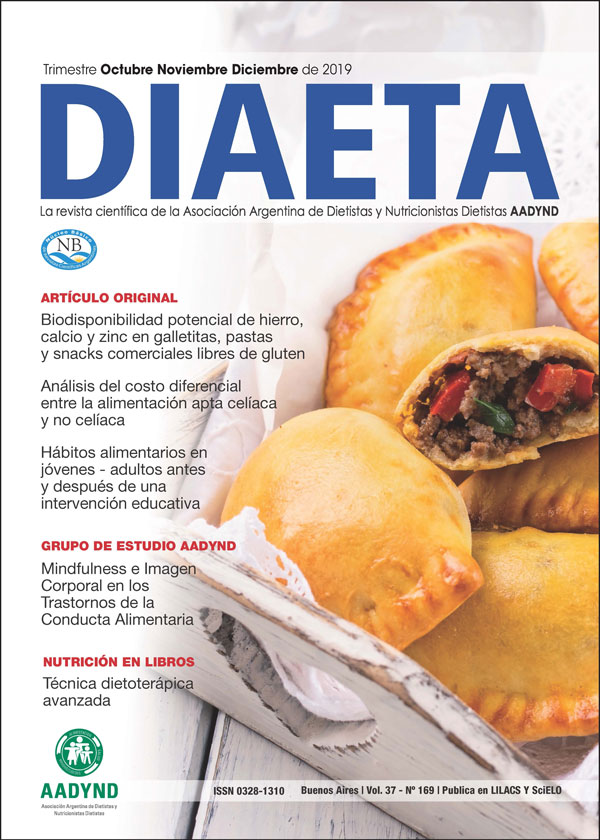Ver ítem
- xmlui.general.dspace_homeCentros e Institutos de InvestigaciónCIA. Centro de Investigaciones de AgroindustriaInstituto de Tecnología de AlimentosArtículos científicosxmlui.ArtifactBrowser.ItemViewer.trail
- Inicio
- Centros e Institutos de Investigación
- CIA. Centro de Investigaciones de Agroindustria
- Instituto de Tecnología de Alimentos
- Artículos científicos
- Ver ítem
Biodisponibilidad potencial de hierro, calcio y zinc en galletitas, pastas y snacks comerciales libres de gluten
Resumen
La prevalencia de enfermedad celíaca se encontraría entre 0,5 y 1%, pero su incidencia está en franco aumento. Esta patología no solo afecta a los niños, actualmente, el 60% de los recién diagnosticados con celiaquía son
adultos. La población celíaca debe seguir como único tratamiento una
dieta libre de gluten. Los productos utilizados comúnmente contienen
pocos ingredientes y no están enriquecidos con micronutrientes como
sus homólogos que contienen
[ver mas...]
La prevalencia de enfermedad celíaca se encontraría entre 0,5 y 1%, pero su incidencia está en franco aumento. Esta patología no solo afecta a los niños, actualmente, el 60% de los recién diagnosticados con celiaquía son
adultos. La población celíaca debe seguir como único tratamiento una
dieta libre de gluten. Los productos utilizados comúnmente contienen
pocos ingredientes y no están enriquecidos con micronutrientes como
sus homólogos que contienen trigo. El objetivo del presente estudio fue
evaluar la biodisponibilidad potencial de hierro, calcio y zinc en diez muestras
comerciales libres de gluten, sin TACC (trigo, avena, cebada y centeno). Se analizaron pastas secas, budines, snacks, galletitas dulces y tostadas saladas. La dializabilidad de los minerales (D) fue determinada por método in vitro que simula el proceso de digestión fisiológico. El contenido total
de minerales fue determinado por espectroscopía de absorción atómica
previa mineralización con una mezcla HNO3-HClO4 (50:50). Se estableció
el aporte potencial (AP) de cada mineral en los distintos productos teniendo
en cuenta su concentración y dializabilidad. Los resultados obtenidos
para las 10 muestras fueron: [Fe] 0,35 a 1,35 mg/%; [Ca] 5 a 315 mg/%; [Zn]
0,15 a 1,11 mg/%. Los valores de D% fueron: Fe 4,5-24,7; Ca 15,7-36,7; Zn
8,4-29,5. El contenido de minerales disponibles fue relativamente bajo. La
bioaccesibilidad de minerales de las muestras depende del elemento y
de la composición del producto analizado. Los alimentos libres de gluten prácticamente no aportan cantidades significativas de hierro. Los aportes de zinc y calcio son realmente bajos para los diferentes grupos etarios con cualquiera de los diez alimentos estudiados. Se concluye que sería conveniente sugerir a los responsables de establecer políticas públicas en el
plano nutricional, que arbitren los medios para que la población que debe
consumir alimentos libres de gluten tenga acceso a alimentos enriquecidos,
fundamentalmente con hierro.
[Cerrar]
The prevalence of celiac disease may be between 0.5 and 1%, but its incidence is in clear increase. This disease not only affects children; currently, 60% of newly diagnosed patients are adults. The only possible treatment for the celiac population is to follow a gluten-free diet. Gluten-free products commonly contain few ingredients and they are not enriched with micronutrients like their wheat-containing counterparts. The objective of the present work
[ver mas...]
The prevalence of celiac disease may be between 0.5 and 1%, but its incidence is in clear increase. This disease not only affects children; currently, 60% of newly diagnosed patients are adults. The only possible treatment for the celiac population is to follow a gluten-free diet. Gluten-free products commonly contain few ingredients and they are not enriched with micronutrients like their wheat-containing counterparts. The objective of the present work was to evaluate the potential bioavailability of iron, calcium and zinc in ten gluten free commercial samples, without TACC
(wheat, oats, barley and rye). Dry pasta, puddings, snacks, sweet cookies and salty toasts were analyzed. Mineral dialyzability (D) was determined by an in vitro method that simulates the physiological digestion process. The total mineral content was determined by atomic absorption spectroscopy after mineralization with an HNO3-HClO4 mixture (50:50). The potential contribution (PC) of each mineral was established in the different products considering its concentration and dialyzability. The results obtained for the 10 samples were: [Fe] 0.35 to 1.35 mg /%; [Ca] 5 to 315 mg /%; [Zn] 0.15 to 1.11 mg /%. The values of D% were: Fe 4.5-24.7; Ca 15.7-36.7; Zn 8.4-29.5. The available mineral content of the gluten-free foods analyzed was relatively low. The bioavailability of minerals in the
samples depends on the element and the composition of the product analyzed. Gluten-free foods do not provide significant amounts of iron.
The contributions of zinc and calcium are very low for the different age groups with any of the ten samples studied. It is concluded that it would be advisable to suggest those responsible for establishing public policies in the nutritional field, to arbitrate the means in order to enable the population that must consume gluten-free foods to have access to enriched foods, fundamentally with iron.
[Cerrar]

Autor
Binaghi, María Julieta;
Ambrosi, Vanina A.;
López, Laura Beatriz;
Fuente
Diaeta (Buenos Aires) 37 (169): 8-17 (2019)
Fecha
2019
Editorial
Asociación Argentina de Dietistas y Nutricionistas Dietistas
ISSN
0328-1310
1852-7337
1852-7337
Formato
pdf
Tipo de documento
artículo
Palabras Claves
Derechos de acceso
Restringido
 Excepto donde se diga explicitamente, este item se publica bajo la siguiente descripción: Creative Commons Attribution-NonCommercial-ShareAlike 2.5 Unported (CC BY-NC-SA 2.5)
Excepto donde se diga explicitamente, este item se publica bajo la siguiente descripción: Creative Commons Attribution-NonCommercial-ShareAlike 2.5 Unported (CC BY-NC-SA 2.5)

